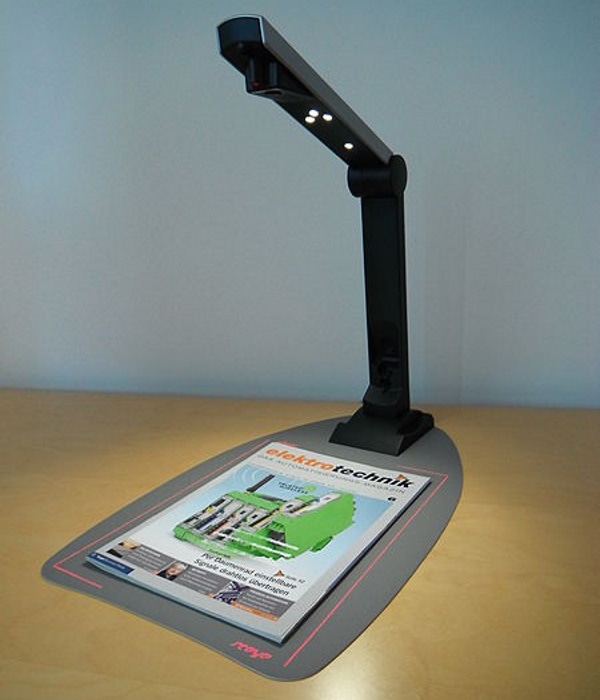What Are Document Cameras & How Do They Work?
Last Updated on

If you’ve been in a classroom recently, you’ve probably seen a document camera. If you haven’t, you probably at least remember its forebearer, the projector.
These are essentially the same devices, but the document camera has a few advanced capabilities that the older projector could only dream of. But what exactly is a document camera, how does it work, and why is it preferable to a projector? Document cameras are Wi-Fi-enabled cameras that live-stream images to projectors or computers.
We answer all those questions and more for you here.

How Does It Work?
Document cameras work in much the same way that regular video cameras work, but they have Wi-Fi capabilities that instantly transfer this image to a projector or a computer.
You set up the document camera, put the document in the correct place, and then turn it on. The document camera records the document and simultaneously live-streams that view to the projector or computer.
Some document cameras have additional features that you can use, but these aren’t necessities. It’s a simple setup, but it requires a stable Wi-Fi connection and a high-quality camera that can successfully enlarge the image without pixelation.
https://www.instagram.com/p/Che5b2NBrHq/
What Are the Different Types of Document Cameras?
When it comes to document cameras, there are three different models that people commonly use. The first is the “lightweight” model. While it doesn’t have the image quality or stabilization of the other two models, if you need a document camera in multiple locations, this option enables you easily move it around from place to place.
The next option is the “large” model. This one typically has a defined area for the document, and it’s not as versatile as the lightweight option. However, it gives you more stability, and the image quality tends to be a bit better.
The final option is the “visualizer.” This is a document camera that you mount to the ceiling. Its advantage is that it can easily highlight much larger objects. You do it with a single document, as well as a whole host of documents or an entire table’s worth of stuff.
A visualizer tends to provide extremely stable and high-quality results, but it can be harder to use it for small objects or a single document.
Since each document camera excels in its own area, it’s not possible to say that one is better or worse than another.
https://www.instagram.com/p/CidSi0hpmEi/
Where Is It Used?
While you can use document cameras in a wide range of settings, one of their most popular uses is in classrooms. They enable the instructor to highlight specific sections of a document.
For example, they can bring up the document on a larger screen in the classroom, or if they’re teaching the class virtually, they can easily highlight the document in the internet session.
Another area where a document camera can be useful is showing people legal documents from a distance in a business setting. But it’s not nearly as common there as it is for classroom use.
Advantages of Document Cameras
The advantage of document cameras is that they make it easier to show a single document to a group of people. People often compare them to projectors, but they’re smaller and lighter, and you can project information over the internet.
You also get higher-quality images, although for most document applications, this isn’t as big of a deal.

Disadvantages of Document Cameras
The disadvantage of document cameras is that they’re basically one-function tools. While they do a great job of making small objects larger on display, you can’t really use them for anything else.
This isn’t necessarily a dealbreaker, but if you’re on a limited budget and need multiple devices, it can be a bit challenging to justify this expense.

Frequently Asked Questions (FAQs)
After learning more about document cameras, many people have a few questions about them. Here are the answers to the most frequently asked questions.
Do Document Cameras Take Pictures?
It depends on the model that you get, but some document cameras can indeed take pictures. This is useful if you want to highlight a particular document, especially if you’re working on it during a presentation.
Can You Use a Document Camera Without a Computer?
This depends on the document camera that you go with, but there are document cameras that you can use without a computer. You’ll still need something to project the image with, though, so for these document cameras, you typically need a projector.
https://www.instagram.com/p/CkbeuuPvpaZ/
Can You Use Your Phone as a Document Camera?
There’s an app for everything, so it’s no surprise that there is indeed an app that can turn your phone into a document camera. But for this app to work effectively, it’s best to have some kind of overhead stand that you can mount your phone on to get a stabilized image.
Do Document Cameras Need a Projector?
Just like you don’t necessarily need a computer, depending on the type of document camera that you go with, you might not need a projector either. But typically, you need either a computer or a projector to use a document camera.

Conclusion
Now that you know more about the document camera, it’s up to you to figure out if you need one or if it’s just a novelty that you might see in various settings.
While it certainly has its uses and advantages, it’s not something that everyone needs. But for those who do need it, it can be a powerful tool that can make things much easier.
Featured Image Credit: Document Camera (Image Credit: JamesMoorey, Wikimedia Commons CC BY-SA 3.0)
About the Author Robert Sparks
Robert’s obsession with all things optical started early in life, when his optician father would bring home prototypes for Robert to play with. Nowadays, Robert is dedicated to helping others find the right optics for their needs. His hobbies include astronomy, astrophysics, and model building. Originally from Newark, NJ, he resides in Santa Fe, New Mexico, where the nighttime skies are filled with glittering stars.
Related Articles:
Binocular Magnification Chart: Numbers & Distances Compared
How to Clean a Refractor Telescope: Step-by-Step Guide
How to Clean a Telescope Eyepiece: Step-by-Step Guide
How to Clean a Rifle Scope: 8 Expert Tips
Monocular vs Telescope: Differences Explained (With Pictures)
What Is a Monocular Used For? 8 Common Functions
How to Clean a Telescope Mirror: 8 Expert Tips
Brightfield vs Phase Contrast Microscopy: The Differences Explained
